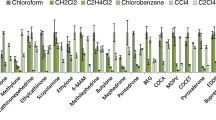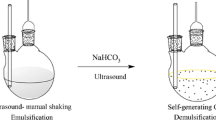Abstract
A new analytical method was developed for simultaneous determination of 12 pharmaceuticals using ultrasound-assisted dispersive liquid–liquid microextraction (DLLME) followed by ultra-high performance liquid chromatography with tandem mass spectrometry (UHPLC-MS/MS). Six nonsteroidal anti-inflammatory drugs (NSAIDs, ketoprofen, mefenamic acid, tolfenamic acid, naproxen, sulindac, and piroxicam) and six antibiotics (tinidazole, cefuroxime axetil, ciprofloxacin, sulfamethoxazole, sulfadiazine, and chloramphenicol) were extracted by ultrasound-assisted DLLME using dichloromethane (800 μL) and methanol/acetonitrile (1:1, v/v, 1200 μL) as the extraction and dispersive solvents, respectively. The factors affecting the extraction efficiency, such as the type and volume of extraction and dispersive solvent, vortex and ultrasonic time, sample pH, and ionic strength, were optimized. The ultrasound-assisted process was applied to accelerate the formation of the fine cloudy solution by using a small volume of dispersive solvent, which increased the extraction efficiency and reduced the equilibrium time. Under the optimal conditions, the calibration curves showed good linearity in the range of 0.04–20 ng mL−1 (ciprofloxacin and sulfadiazine), 0.2–100 ng mL−1 (ketoprofen, tinidazole, cefuroxime axetil, naproxen, sulfamethoxazole, and sulindac), and 1–200 ng mL−1 (mefenamic acid, tolfenamic acid, piroxicam, and chloramphenicol). The LODs and LOQs of the method were in the range of 0.006–0.091 and 0.018–0.281 ng mL−1, respectively. The relative recoveries of the target analytes were in the range from 76.77 to 99.97 % with RSDs between 1.6 and 8.8 %. The developed method was successfully applied to the extraction and analysis of 12 pharmaceuticals in five kinds of water samples (drinking water, running water, river water, influent and effluent wastewater) with satisfactory results.

Twelve pharmaceuticals in water samples analyted by UHPLC-MS/MS using ultrasound-assisted DLLME



Similar content being viewed by others
References
Fent K, Weston AA, Caminada D. Ecotoxicology of human pharmaceuticals. Aquat Toxicol. 2006;76:122–59.
Segura PA, Francois M, Gagnon C, Sauvé S. Review of the occurrence of anti-infectives in contaminated wastewaters and natural and drinking waters. Environ Health Perspect. 2009;117:675–84.
Kümmerer K. Drugs in the environment: emission of drugs, diagnostic aids and disinfectants into wastewater by hospitals in relation to other sources—a review. Chemosphere. 2001;45:957–69.
Ternes TA, Joss A. Human pharmaceuticals, hormones and fragrances. The challenge of micropollutants in urban water management. London: IWA Publishing; 2006. p. 243–88.
Patrolecco L, Capri S, Ademollo N. Occurrence of selected pharmaceuticals in the principal sewage treatment plants in Rome (Italy) and in the receiving surface waters. Environ Sci Pollut Res. 2015;22:5864–76.
Yang GCC, Liou SH, Wang CL. The influences of storage and further purification on residual concentrations of pharmaceuticals and phthalate esters in drinking water. Water Air Soil Pollut. 2014;225:1–11.
Radović T, Grujić S, Petković A, Dimkić M, Laušević M. Determination of pharmaceuticals and pesticides in river sediments and corresponding surface and ground water in the Danube River and tributaries in Serbia. Environ Monit Assess. 2015;187:4092–109.
Fatta-Kassinos D, Meric S, Nicolaou A. Pharmaceutical residues in environmental waters and wastewater: current state of knowledge and future research. Anal Bioanal Chem. 2011;399:251–75.
Meffe R, Bustamante I. Emerging organic contaminants in surface water and groundwater: a first overview of the situation in Italy. Sci Total Environ. 2014;481:280–95.
Gros M, Petrović M, Barceló D. Wastewaters treatment plants as a pathway for aquatic contamination by pharmaceuticals in the Ebro River basin (Northeast Spain). Environ Toxicol Chem. 2007;26:1553–62.
Halling-Sørensen B, Nielsen SN, Lanzky PF, Ingerslev F, Holten Lützhøft HC, Jørgensen SE. Occurrence, fate and effects of pharmaceutical substances in the environment: a review. Chemosphere. 1998;3:357–93.
Khan U, Nicell J. Human health relevance of pharmaceutically active compounds in drinking water. AAPS J. 2015;17:558–85.
Leung HW, Jin L, Wei S, Tsui MMP, Zhou BS, Jiao LP, et al. Pharmaceuticals in tap water: human health risk assessment and proposed monitoring framework in China. Environ Health Perspect. 2013;121:839–46.
Petrović M, Hernando MD, Díaz-Cruz MD, Barceló D. Liquid chromatography–tandem mass spectrometry for the analysis of pharmaceutical residues in environmental samples: a review. J Chromatogr A. 2005;1067:11–4.
Petrovic M, Farré M, Lopez de Alda M, Perez S, Postigo C, Köck M, et al. Recent trends in the liquid chromatography–mass spectrometry analysis of organic contaminants in environmental samples. J Chromatogr A. 2010;1217:4004–17.
Wille K, De Brabander HF, De Wulf E, Van Caeter P, Janssen CR, Vanhaecke L. Coupled chromatographic and mass-spectrometric techniques for the analysis of emerging pollutants in the aquatic environment. Trends Anal Chem. 2012;35:87–108.
Staniszewska M, Wolska L, Namieśnik J. New approach based on solid-phase extraction for the assessment of organic compound pollutions in so-called pharmaceutically pure water. Anal Bioanal Chem. 2008;391:1941–9.
Berthod L, Roberts G, Mills GA. A solid-phase extraction approach for the identification of pharmaceutical–sludge adsorption mechanisms. J Pharm. 2014;4:117–24.
David R, Kasprzyk-Hordernb BB. Critical evaluation of methodology commonly used in sample collection, storage and preparation for the analysis of pharmaceuticals and illicit drugs in surface water and wastewater by solid phase extraction and liquid chromatography–mass spectrometry. J Chromatogr A. 2011;1218:8036–59.
Padrón T, Esther M, Cristina AO, Zoraida SF, Santana-Rodríguez JJ. Microextraction techniques coupled to liquid chromatography with mass spectrometry for the determination of organic micropollutants in environmental water samples. Molecules. 2014;19:10320–49.
Farajzadeh MA, Sorouraddin SM, Mogaddam MRA. Liquid phase microextraction of pesticides: a review on current methods. Microchim Acta. 2014;181:829–51.
Hiroyuki K. New trends in sample preparation for analysis of plant-derived medicines. Curr Org Chem. 2010;14:1698–713.
Larsson N, Petersson E, Rylander E, Jönsson JA. Continuous flow hollow fiber liquid-phase microextraction and monitoring of NSAID pharmaceuticals in a sewage treatment plant effluent. Anal Methods. 2009;1:59–67.
Díaz-Álvarez M, Esther T, Martín-Esteban A. Hollow fibre liquid-phase microextraction of parabens from environmental waters. Int J Environ Anal Chem. 2013;93:727–38.
Sarafraz-yazdi A, Assadi H, Es’haghi Z, Danesh NM. Pre-concentration of non-steroidal anti-inflammatory drugs in water using dispersive liquid–liquid and single-drop microextraction with high-performance liquid chromatography. J Sep Sci. 2012;35:2476–83.
Zhang J, Lee HK. Application of dynamic liquid-phase microextraction and injection port derivatization combined with gas chromatography–mass spectrometry to the determination of acidic pharmaceutically active compounds in water samples. J Chromatogr A. 2009;1216:7527–32.
Rezaee M, Assadi Y, Hosseini MRM, Aghaee E, Ahmadi F, Berijani S. Determination of organic compounds in water using dispersive liquid–liquid microextraction. J Chromatogr A. 2006;1116:1–9.
Zgoła-Grześkowiak A, Grześkowiak T. Dispersive liquid-liquid microextraction. Trends Anal Chem. 2011;30:1382–99.
Mohammad R, Yadollah Y, Mohammad F. Evolution of dispersive liquid-liquid microextraction method. J Chromatogr A. 2010;1217:2342–57.
Regueiro J, Llompart M, Garcia-Jares C, Garcia-Monteagudo JC, Cela R. Ultrasound-assisted emulsification–microextraction of emergent contaminants and pesticides in environmental waters. J Chromatogr A. 2008;1190:27–38.
Albero B, Sánchez-Brunete C, García-Valcárcel AI, Rosa A, José P, Tadeo L. Ultrasound-assisted extraction of emerging contaminants from environmental samples. TrAC Trends Anal Chem. 2015;71:110–8.
Parrilla Vázquez MM, Parrilla Vázquez P, Martínez Galera M, Gil García MD, Uclés A. Ultrasound-assisted ionic liquid dispersive liquid–liquid microextraction coupled with liquid chromatography-quadrupole-linear ion trap-mass spectrometry for simultaneous analysis of pharmaceuticals in wastewaters. J Chromatogr A. 2013;1291:19–26.
Yan H, Wang H, Qin X, Liu B, Du J. Ultrasound-assisted dispersive liquid–liquid microextraction for determination of fluoroquinolones in pharmaceutical wastewater. J Pharmaceut Biomed. 2011;54:53–7.
Wu H, Li G, Liu S, Liu D, Chen G, Hu N, et al. Simultaneous determination of six triterpenic acids in some Chinese medicinal herbs using ultrasound-assisted dispersive liquid–liquid microextraction and high-performance liquid chromatography with fluorescence detection. J Pharmaceut Biomed. 2015;107:98–107.
Oaks JL, Gilbert M, Virani MZ, Watson RT, Meteyer CU, Rideout BA, et al. Diclofenac residues as the cause of vulture population decline in Pakistan. Nature. 2004;427:630–3.
Kümmerer K. Significance of antibiotics in the environment. J Antimicrob Chemother. 2003;52:5–7.
Liu X, Lee J, Ji K, Takeda S, Choi K. Potentials and mechanisms of genotoxicity of six pharmaceuticals frequently detected in freshwater environment. Toxicol Lett. 2012;211:70–8.
Liang N, Huang PT, Hou XH, Li Z, Tao L, Zhao LS. Solid-phase extraction in combination with dispersive liquid-liquid microextraction and ultra-high performance liquid chromatography-tandem mass spectrometry analysis: the ultra-trace determination of 10 antibiotics. Anal Bioanal Chem. 2016;408:1701–13.
Celano R, Piccinelli AL, Campone L, Rastrelli L. Ultra-preconcentration and determination of selected pharmaceutical and personal care products in different water matrices by solid-phase extraction combined with dispersive liquid-liquid microextraction prior to ultra high pressure liquid chromatography tandem mass spectrometry analysis. J Chromatogr A. 2014;1355:26–35.
Yiantzi E, Psillakis E, Tyrovola K, Kalogerakis N. Vortex-assisted liquid-liquid microextraction of octylphenol, nonylphenol and bisphenol-A. Talanta. 2010;80:2057–62.
Zhao RS, Wang X, Li FW, Wang S, Zhang LL, Cheng CG. Ionic liquid/ionic liquid dispersive liquid-liquid microextraction. J Sep Sci. 2011;34:830–6.
Kebarle P, Tang L. From ions in solution to ions in the gas phase. Anal Chem. 1993;65:972A–86.
Niessen WMA, Manini P, Andreoli R. Matrix effects in quantitative pesticide analysis using liquid chromatography-mass spectrometry. Mass Spectrom Rev. 2006;25:881–99.
Kotowska U, Kapelewska J, Sturgulewska J. Determination of phenols and pharmaceuticals in municipal wastewaters from Polish treatment plants by ultrasound-assisted emulsification-microextraction followed by GC–MS. Environ Sci Pollut Res. 2014;21:660–73.
Herrera-Herrera AV, Hernandez-Borges J, Borges-Mique TM, Rodriguez-Delgado MA. Dispersive liquid-liquid microextraction combined with ultra-high performance liquid chromatography for the simultaneous determination of 25 sulfonamide and quinolone antibiotics in water samples. J Pharmaceut Biomed. 2013;75:130–7.
Ferńandez P, Regenjo M, Ferńandez AM, Lorenzo RA, Carro AM. Optimization of ultrasound-assisted dispersive liquid–liquid microextraction for ultra performance liquid chromatography determination of benzodiazepines in urine and hospital wastewater. Anal Methods. 2014;6:8239–46.
Caldas SS, Rombaldi C, Arias JLDO, Marube LC, Primel EG. Multi-residue method for determination of 58 pesticides, pharmaceuticals and personal care products in water using solvent demulsification dispersive liquid–liquid microextraction combined with liquid chromatography-tandem mass spectrometry. Talanta. 2016;146:676–88.
Nishi I, Kawakami T, Onodera S. Monitoring the concentrations of nonsteroidal anti-inflammatory drugs and cyclooxygenase-inhibiting activities in the surface waters of the Tone Canal and Edo River Basin. J Environ Sci Health A. 2015;50:1108–15.
Acknowledgments
This work was sponsored by the National Natural Science Foundation of China (grant nos. 21477082 and 81503029), Liaoning Province Educational Department (L-2014160), Liaoning Province Natural Science Foundation of China (no. 2015020701), and by Large Instrument Sharing Service Construction Special of Shenyang Science and Technology Innovation Fund (no. F14-195-4-00).
Author information
Authors and Affiliations
Corresponding authors
Ethics declarations
Conflict of interest
The authors declare that they have no competing interests.
Electronic supplementary material
Below is the link to the electronic supplementary material.
ESM 1
(PDF 584 kb)
Rights and permissions
About this article
Cite this article
Guan, J., Zhang, C., Wang, Y. et al. Simultaneous determination of 12 pharmaceuticals in water samples by ultrasound-assisted dispersive liquid–liquid microextraction coupled with ultra-high performance liquid chromatography with tandem mass spectrometry. Anal Bioanal Chem 408, 8099–8109 (2016). https://doi.org/10.1007/s00216-016-9913-1
Received:
Revised:
Accepted:
Published:
Issue Date:
DOI: https://doi.org/10.1007/s00216-016-9913-1




